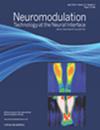难治性慢性背部和/或下肢神经痛患者脊髓刺激、背根神经节刺激及两者结合治疗的比较:一项前瞻性、随机、双盲、交叉试验(BOOST-DRG 研究)。
IF 3.2
3区 医学
Q2 CLINICAL NEUROLOGY
引用次数: 0
摘要
目的:脊髓刺激(SCS)和背根神经节刺激(DRGS)对缓解脊柱手术后持续性脊柱疼痛综合征(PSPS-T2)患者的疼痛有单独疗效。将 SCS 和 DRGS 同时与 Burst 刺激程序结合使用,可提高 PSPS-T2 患者的应答率:本研究旨在通过对 PSPS-T2 患者进行为期三个月的随机交叉试验,比较 SCS、DRGS 和 SCS+DGRS (DUAL) 的疼痛缓解率(≥50%)。交叉试验结束后,刺激程序改为 Burst。次要目标包括评估3个月、4个月、6个月和12个月随访的临床疗效,评估疼痛强度、疼痛面积、麻痹覆盖面积、生活质量、功能障碍、心理困扰、药物摄入量和多维临床反应指数(MCRI):交叉期结束时,SCS、DRGS 和 DUAL 的疼痛缓解率相似(60%,p = 0.84),随着刺激可能性的切换,疼痛缓解率增至 80%。在四个月的随访中,猝发编程并未提供额外的疼痛缓解效果(p = 0.99)。与基线相比,12 个月随访前的临床效果明显改善。考虑到 MCRI 1.05 的临床显著增长,所有患者在 3 个月、4 个月和 6 个月的随访中均有反应,与基线相比,80% 的患者在 12 个月时有反应:完全可以选择分别或同时刺激不同的神经结构,从而提高了应答率,使患者能够进行个性化治疗。多维度评估对于揭示神经调控对慢性疼痛患者的全部潜在益处至关重要。本文章由计算机程序翻译,如有差异,请以英文原文为准。
Comparison of Spinal Cord Stimulation, Dorsal Root Ganglion Stimulation, and Association of Both in Patients With Refractory Chronic Back and/or Lower Limb Neuropathic Pain: A Prospective, Randomized, Double-Blind, Cross-Over Trial (BOOST-DRG Study)
Objectives
Spinal cord stimulation (SCS) and dorsal root ganglion stimulation (DRGS) have individually shown efficacy in relieving pain in patients with persistent spinal pain syndrome after spinal surgery (PSPS-T2). Combining SCS and DRGS simultaneously, along with Burst stimulation programming, may enhance the responder rate of patients with PSPS-T2.
Material and Methods
This study aimed to compare the pain relief (≥50%) responder rates in SCS, DRGS, and SCS+DGRS (DUAL) through a three-month randomized cross-over trial in patients with PSPS-T2. After the cross-over period, stimulation programming was switched to Burst. Secondary objectives included evaluating the clinical efficacy at three-, four-, six-, and 12-month follow-ups, assessing pain intensity, area of pain, area of paresthesia coverage, quality of life, functional disability, psychologic distress, medication intake, and the Multidimensional Clinical Response Index (MCRI).
Results
The responder rate of pain relief was similar in SCS, DRGS, and DUAL (60%, p = 0.84) at the end of the cross-over period, increasing to 80% with the ability to switch between stimulation possibilities. Burst programming did not provide additional pain relief at the four-month follow-up (p = 0.99). Clinical outcomes significantly improved until 12-month follow-up compared with baseline. Considering a clinically significant increase of 1.05 of the MCRI, all patients were responders at three-, four-, and six- month follow-up, and 80% were responders at 12 months compared with baseline.
Conclusions
The full option to stimulate different neural structures, separately or simultaneously, led to improved responder rates, allowing patients to personalize treatment. A multidimensional assessment is essential to reveal the full potential benefits of neuromodulation in patients with chronic pain.
求助全文
通过发布文献求助,成功后即可免费获取论文全文。
去求助
来源期刊

Neuromodulation
医学-临床神经学
CiteScore
6.40
自引率
3.60%
发文量
978
审稿时长
54 days
期刊介绍:
Neuromodulation: Technology at the Neural Interface is the preeminent journal in the area of neuromodulation, providing our readership with the state of the art clinical, translational, and basic science research in the field. For clinicians, engineers, scientists and members of the biotechnology industry alike, Neuromodulation provides timely and rigorously peer-reviewed articles on the technology, science, and clinical application of devices that interface with the nervous system to treat disease and improve function.
 求助内容:
求助内容: 应助结果提醒方式:
应助结果提醒方式:


